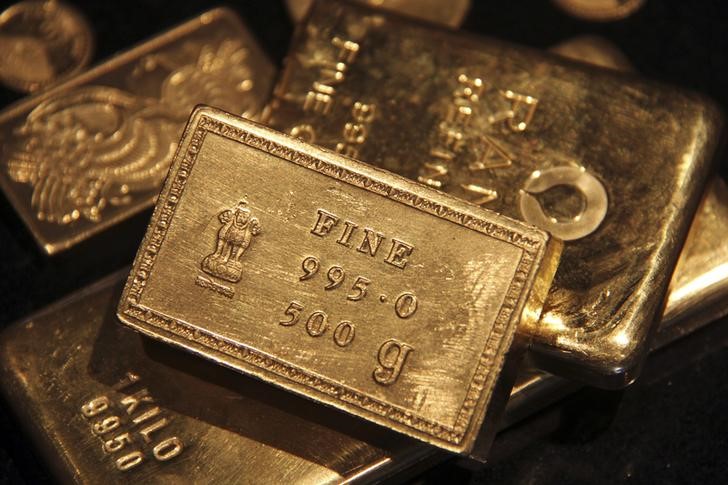Investing.com -- Gold traders heard out Jay Powell, sending the market to 3-month lows as he spoke. When he finished, they bought back most of what they had sold, an indication perhaps that the Fed chair’s hawkish script could not shock markets anymore than they were prepared for.
The front-month gold contract on New York’s Comex settled at $1,933.30 an ounce, down just $2.20, or 0.1%, on the day. Earlier, it fell to $1,929.75 — its lowest since mid-March.
The spot price of gold, which reflects physical trades in bullion and is more closely followed than futures by some traders, was at $1,934.82 by 14:10 ET (18:10 GMT), down $1.53, or 0.08% on the day. It tumbled to a three-month low of $1,919.44 earlier.
Notwithstanding Wednesday’s comeback, some analysts predicted further weakness in gold as the Fed stayed on the path of higher rates.
“Gold has broadly traded between $1,940-$1,980 over the last month, very briefly moving outside of this range on a few occasions,” said Craig Erlam, analyst at online trading platform OANDA. “Traders will be on high alert for a more substantial breakout to the downside.”
Powell stays hawkish on rates; Gold market takes it in stride
Gold tumbled as Powell began his biennial address to Congress, sticking to the hawkish spiel he adopted at the Fed’s post-rate decision news conference from June 14, where the central bank paused on its more than year-long monetary tightening.
But as markets realized that the speech was more like old wine in a new bottle, the dollar which had been rallying on Powell's words, lost its strength. Gold, conversely, came back from its dizzying drop, recovering almost everything it had lost.
For context, Powell said nearly all policy-makers at the central bank think there should be more rate hikes to curb inflation. That was a sign that the June pause in the Fed’s year-long campaign of monetary tightening was just that — a pause.
The Fed’s next decision on rates is scheduled on July 26, with many economists already predicting the central bank will add another quarter percentage point to rates, bringing them to a peak of 5.5% in a bid to further tame inflation.
"Inflation has moderated somewhat since the middle of last year," Powell said, noting that it also "has a long way to go" in meeting the central bank’s cherished target.
Inflation continues to stay above Fed’s accepted norm
The Consumer Price Index, the broadest gauge of U.S. inflation, grew by 4% in the year to May, expanding at its slowest pace in more than two years. The Personal Consumption Expenditures Index, the Fed’s preferred inflation gauge, meanwhile, grew by 4.4% in the year to April. Both are, however, at least twice above the Fed’s 2% target for annual inflation.
The central bank, in response, has raised rates by 5% since the end of COVID-19 outbreak in March 2020.
Powell’s comments came in the wake of Tuesday’s data showing groundbreaking U.S. single-family home-building projects, up their most in more than three decades in May. Permits for future construction also climbed, suggesting that the housing market was turning a corner despite getting clobbered by Fed’s rate hikes.
Mark Luschini, chief investment strategist at Janney Montgomery Scott, said the bullish housing starts may complicate the "formula around what the Federal Reserve is going to have to do in order to tame inflation".
Powell acknowledged those thoughts in his speech.
“It will take time, however, for the full effects of monetary restraint to be realized, especially on inflation,” he said, pointing to a “tight” labor market where demand “still substantially exceeds the supply of available workers”.
The labor market is the juggernaut of the U.S. economy, adding hundreds of thousands of jobs a month over the past three years after initially losing 20 million to the COVID-19 pandemic.
While policy-makers the world over typically celebrate on seeing good jobs numbers, the Fed is in a different predicament. The central bank wishes to see an easing of conditions that are a little “too good” now for the economy’s own good — in this case, unemployment at more than 50-year lows and average monthly wages that have grown without stop since March 2021.
Such job security and earnings have cushioned many Americans from the worst price pressures since the 1980s and encouraged them to continue spending, further feeding inflation.
The Fed has a mandate of ensuring “maximum employment” through a jobless rate of 4% or below, and keeping inflation “manageable”. The last was a task easily achieved before the COVID-19 breakout, when prices expanded less than 2% a year. The pandemic and the trillions of dollars of relief spending by the government, however, triggered runaway inflation since mid-2021.
